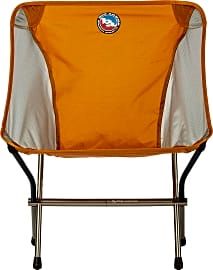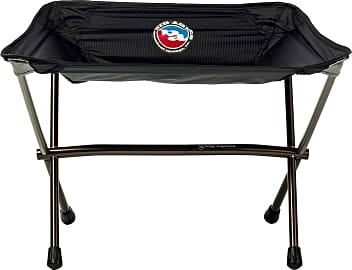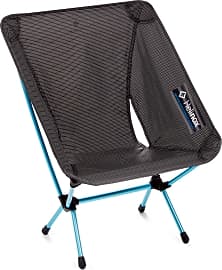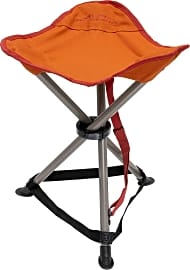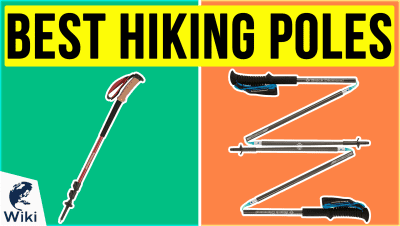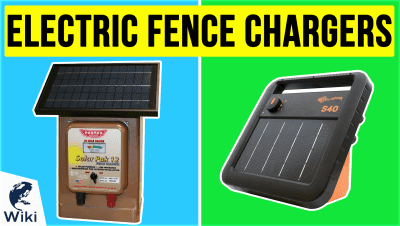The 7 Best Backpacking Chairs

This wiki has been updated 34 times since it was first published in October of 2016. Trekking through the wilderness can be exhausting, and even the most seasoned hiker needs to sit down once in a while. These backpacking chairs are specifically designed with lightweight frames for both portability and comfort, and let you take a load off after a long day's journey. They range in style from minimalist tripods to resilient recliners, and some even have cupholders. When users buy our independently chosen editorial selections, we may earn commissions to help fund the Wiki.
Editor's Notes
July 23, 2021:
Sadly, a couple favorites from Alite as well as a novel combination table/chair from Therm-a-rest are all difficult to find at this time, so we no longer recommend them. We also upgraded the Big Agnes Skyline to the Big Agnes Skyline Stool, because we have a lot of great chairs on the list but wanted to highlight a stool that's suitable for taller people. The rest of our choices remain the same, with the Helinox One still at the top spot and the Big Agnes Mica Basin a great option for big and tall hikers.
July 26, 2020:
Even if you've spent very little time looking at camping or hiking gear, you probably won't be surprised to see backpacking chairs from Big Agnes and Helinox on this list. In fact, Helinox used to be associated with Big Agnes, although the former brand has now struck out on its own. This hasn't changed the quality these two companies are known for, however, with the popular Helinox One and the Big Agnes Mica Basin taking the top spots. We kept the Big Agnes Skyline, as well. It's quite similar to the Mica Basin, but it has a slightly lower weight capacity to match its lower overall weight. There's also the Helinox Zero, but note that for the best stability, you'll need to purchase the ground sheet separately, adding to the overall cost.
For something a little different, we kept the Mountainsmith Slingback, which relies on hiking poles to work, as well as the Crazy Creek Hex 2.0 PowerLounger, a handy tool that doubles as a camping pad. We've also opted to keep one stool, but we chose the Alps Mountaineering Tri-Leg Stool over the Petrous Tripod. Although the Petrous model is light and compact, some find it a little hard to put together — just what you don't need when you're tired. The Alps Mountaineering goes together quickly, though, and offers two carrying methods, with or without its sack.
April 12, 2019:
A chair is not the first thing on the ultralight backpacker's list, but after years of sitting on rocks and logs, this author can personally attest to just how nice it is to have a dedicated sitting device in your arsenal. You'll notice right off the bat that a lot of these models are manufactured by Big Agnes, a Colorado-based company that does a fantastic job designing lightweight equipment. Their Helinox products are exceptionally popular, and for good reason, though the Skyline is significantly lighter than the much-talked-about Helinox One, and as such makes a strong argument for being the top choice. The Hexalite and Mountainsmith are interesting options because while they aren't the easiest to get in and out of, they are ridiculously lightweight, and the Hexalite can also serve as a decent sleeping pad, eliminating just that much extra weight, bulk, and cost from your budget. The Therm-a-Rest Uno is another dual-purpose model, adding a small yet versatile table to your back, which is yet another luxury that a lot of backpackers don't think about including at first. Then again, a lot of trail minimalists are also very frugal consumers, and will appreciate the Trekology's particularly low cost. If you're going for a small footprint in addition to a low weight, consider the Petrous, which although it doesn't have a chair back, is another incredibly well-priced option. Larger users or those who like to drink beverages while relaxing (and who doesn't?) should check out the Alite Stonefly, which has especially comfortable armrests in addition to two places to put a bottle, can, or cup. Just remember to pack out your trash.
Special Honors
L.L.Bean Aero Insulated Trail Chair It doesn't pack down or roll up as compactly as some others, but the L.L.Bean Aero Insulated Trail Chair is nevertheless a helpful tool for relaxing when the weather is frigid. There's enough cushioning to make a hard or lumpy surface comfortable, while the aerogel insulation stops the ground from stealing your body heat. llbean.com
REI Co-op Flexlite Air Even though the REI Co-op Flexlite Air is exceptionally light at a mere one pound, it can comfortably hold up to 250 pounds, with a seat height of 11 inches. It is manufactured with a focus on sustainability, and features a ripstop nylon that is Bluesign approved. rei.com
Stop Squatting And Start Relaxing
We totally know that you could hike off into the woods like Bear Grylls and survive for days, weeks even, with only a pocket knife and a compass.
We totally know that you could hike off into the woods like Bear Grylls and survive for days, weeks even, with only a pocket knife and a compass. Luxury? Isn’t that something for casual day hikers who never learned to minimize their gear properly? Actually, there are some pretty good reasons to pack along one or two creature comfort items for your next distance, thru, or day hike, with the backpacking chair being an excellent top choice.
In the first place, while it’s true that some areas do indeed have natural seats, such as logs, not all areas are so blessed. There’s no guarantee, in other words, that you won’t have to sit on the ground. And if you’ve just covered a score of grueling miles, it’s likely that you aren’t going to have the energy to search for something upon which to park yourself. With a backpacking chair at the ready, you’ll be restfully seated in no time, and you won’t need to worry about the creepy crawlies skittering around on the ground.
There’s also the weather to consider. When people espouse the benefits of traveling without a backpacking chair, they offer solutions that make sense when it’s dry. But wet, muddy, or snowy ground is a reality that most hikers end up facing at some point, and it’s one that makes demands beyond comfort. If you’re already cold, you probably shouldn’t put yourself on wet ground with no insulation. You need to protect your body heat, which will be easier from a dry chair.
Think, too, that you’ll be able to eat in a comfortable position, which can greatly impact your mental state after a rough day on the trail. After you fuel up, you may want to read or play some cards with your hiking companions, activities that are less of a hassle when you’re seated comfortably. True, you can certainly do these things while seated on a stump, but have you ever really tried to sit with no back support for any length of time?
Finally, some truly amazing hikers have health challenges that make having a stable and supportive seat a must. If you have back pain, for instance, there’s nothing wrong with not wanting to flop down on a cold, hard rock. Hike your own hike, as they say, and carry what you need to make you comfortable.
Backpacking Chair Design
Because backpacking requires allotting space wisely, chairs made specifically for this activity aren’t like those created for other recreations, including car camping. When you go car camping, your vehicle does most of the work of hauling your gear, meaning a chair can be larger or heavier without causing you too much extra effort. When you’re carrying everything on your back, however, you’ll definitely feel every extra ounce. That’s why backpacking chairs are usually lighter and smaller than typical camping chairs.
Backpacking chairs also use design to capitalize on available room.
Backpacking chairs also use design to capitalize on available room. Many are dual-purpose, a principle that’s crucial when space is at a premium. You’ll see backpacking chairs that function as tables or sleeping pads, which means less to carry. Another popular type cleverly uses the hiking poles that backpackers generally carry. When not in use, most backpacking chairs fold, roll, or compress into an easily packable size, a feat that designers achieve by omitting any pieces that are not absolutely critical to the chair’s functionality.
For this reason, many backpacking chairs take a little getting used to — don’t be surprised if you need to get in and out of one a few times before it feels natural. Often, these chairs don’t have the same type of supports as a typical camping chair, so you can’t press down or lean on them in a typical manner. After a few uses, you should begin to feel comfortable with how to shift your weight.
And, although it’s probably at the bottom of your list of concerns, some backpacking chairs do look pretty amazing. Designers today have an abundance of ultra-functional materials at their disposal, materials that repel water, weigh little, resist tearing, breathe well, and come in tons of colors. You might find yourself looking for any excuse to pop your chair out of your pack, just to show off a little.
A Brief History Of Backpacking The Appalachian Trail
Whether you’re new to hiking or you're an old pro, it’s likely that you’ve heard of the perennially popular Appalachian Trail. Sometimes called the A.T., this trail covers 2,190 miles between Georgia and Maine, hitting a total of 14 states along the way. While it’s estimated that between 2 and 3 million people hike portions of this trail every year, the number of “2,000 milers,” or those who walk the trail in its entirety, is much smaller, between 500 and 1,200 hikers each year.
Since Shaffer’s first journey, more than 15,000 people have reported tackling this hike.
The journey of self-discovery that is walking the length of the A.T. traces its origins back to 1948, when U.S. Army veteran Earl V. Shaffer reported the first thru-hike. While this is considered an accomplishment even today, remember that Shaffer didn’t have the benefit of guidebooks, GPS, ample volunteers to keep the trail in shape, or trail angels. He certainly couldn’t rely on today’s lightweight backpacking chairs and accessories for comfort. In fact, the trail was only about 10 years old, having been flagged through the hard work of ATC Chair Myron Avery in 1936.
Since Shaffer’s first journey, more than 15,000 people have reported tackling this hike. Although the activity may seem like it’s reserved for elite athletes, the trail is open to anyone with a decent level of fitness and the will to walk, including those over the age of 60, individuals with disabilities, vegetarians and vegans, insulin-dependent diabetics, and solo female hikers. Many read Shaffer’s book, “Walking With Spring,” for inspiration.


